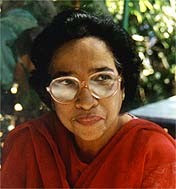Germaine de Stael was
one of the early feminists who championed women’s right to self expression.
Hailed as an important intellectual of her time, she was also ridiculed as ‘man
woman,’ because she was strong willed, decisive and took a definite stand on
issues close to her heart. She was dominating and bossy and knew how to
influence people to further her own ends. There were three different facets to
her character – political, intellectual and sexual- distinct and running side
by side.
Germaine’s one disappointment was that she failed to
inspire Napoleon to envision her goals. At the outset, she was willing to
proclaim Napoleon as great, provided he considered some of her ideas to turn
France into an outstanding nation. A confirmed misogynist, Napoleon not only
spurned her ideas but laughed at her attempts to influence him. He hated loud
mouthed, self opinionated women and was immune to her charms. He preferred
docile, submissive creatures like his wife Josephine or his mistress Mario
Walewski.
“Who is the greatest
woman in history?” she asked him.
“It is the woman who
has borne the most children,” he replied, making her seethe with frustration.
Germaine had a striking personality but was by no means
beautiful. She was on the pudgy side with an enormous bosom, and her deep
necked attire revealed much of her bulging breasts. On one occasion, he peeped
into her cleavage and had the impertinence to ask how many children she had
suckled.
As Napoleon’s power grew turning him into a ruthless
dictator, Germaine’s opposition to him escalated. She turned her father’s
chateau at Coppet into an intellectual power house and a refuge for those who
opposed Napoleon. She forcefully incited opposition against him. Her salon in
Paris became a prominent political centre. She was constantly at loggerheads
with the regime in France and encouraged her friends Talleyrand, Narbonne and
Benjamin Constant to speak against government proposals.
Napoleon considered her an enemy of the State. She was
exiled three times from France, for short periods between 1803 – 1812. He
persecuted Germaine at every possible opportunity, as he was aware of her great
influence on anti-Bonapartists. Her book on Germany which introduced German
Romanticism and Philosophy to France was seized by Napoleon’s police in 1810,
as being UnFrench and subversive, and burned. It was subsequently published in
London in 1813.
Germaine put together a coalition that brought down
Napoleon. Treaty negotiations between Russia and Sweden were mediated through
her.
She came back to Paris
only after Napoleon abdicated. Attempts to usher in Constitutional Monarchy
were framed in her salon in Paris.
Germaine was also an accomplished writer, though she
never became as popular as her contemporaries Fanny Burney and Jane Austen. She
did her finest writing in exile. Her books Delphine and Corrine or Italy were
well known. Corrine published in 1807 made a great impact on women outside
France. Corrine became an international symbol of Romanticism. Many famous
women modeled their lives on the protagonist of this book. Germaine also had good friends among the
Intelligentsia of Europe like Byron, Schiller, Goethe, Chateaubriand and
others.
Germaine was born Anne Louise Germaine Necker in Paris on
April 26, 1766. Her father Jacques Neckar a Swedish protestant, was Director of
Finance under Louis XVI, but was dismissed in 1788. Germaine was his only child
and he loved her very much, calling her his little ‘Minette.’ Her mother
Suzanne Curchod a French intellectual was very dominating and showed no
affection for her daughter. Germaine disliked her mother intensely.
Germaine was married to Eric Magnus Stael von Holstein a
Swiss nobleman who was eighteen years her senior. Through her father’s influence,
he was made Permanent Ambassador to France. Germaine was now Baroness de Stael,
the richest heiress in France. But they separated a few years later, giving her
the freedom to dally with a succession of men. She was a sensual woman and of
the five children she bore only one was sired by her husband. Viscount Louis
Narbonne was the father of her two children Auguste and Albert. She had many
brief flings.
But the love of her life was Benjamin Constant, French
author and political leader and their affair lasted on and off for seventeen
years. Theirs was an intellectual and romantic bonding, exciting but also exhausting.
Constant was the father of her daughter Albertine.
He described Germaine as
a demanding lover and an attention seeker. “Everybody’s entire existence, every
hour, every minute, for years on end, must be at her disposal or there was an explosion
like all thunderstorm and earthquake together.”
Her last lover was Lt. John Rocca, twenty years her junior.
When her husband died in 1802, she married Rocca secretly. This was not known until
after her death. She bore him a son.
During her last years, this witty, voluble, bold woman began
to abuse opium and was laid low with severe stomach pains. She suffered a stroke,
and passed away on July 14, 1817, Bastille Day. She was just 51 years old. Her husband
died six months later from TB.
During her lifetime Germaine weathered many political upheavals
- the last years of the Monarchy, the French Revolution, Napoleon’s rule and post
Napoleon years. Napoleon said of her, “How does it happen that all who speak to
her come to like me less and less.”






